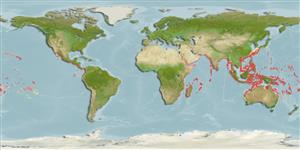Environment: milieu / climate zone / depth range / distribution range
Ökologie
seewasser riff-verbunden; standorttreu; tiefenbereich 100 - 200 m (Ref. 86942). Deep-water; 35°N - 34°S
Indo-West Pacific: tropical, known only from a few scattered localities.
Length at first maturity / Size / Gewicht / Alter
Maturity: Lm 31.0 range ? - ? cm
Max length : 55.0 cm TL Männchen/unbestimmt; (Ref. 2295); common length : 35.0 cm TL Männchen/unbestimmt; (Ref. 2295)
Rückenflossenstacheln (insgesamt): 10; Rückenflossenweichstrahlen (insgesamt): 10; Afterflossenstacheln 3; Afterflossenweichstrahlen: 10. The inner surface of the pectoral fin axil without scales. Overall color is silvery-gray with yellowish suffusion; scale margins are narrowly brownish. Indistinct dark blotches or bars are sometimes apparent on the body. The lips are whitish to yellow. The fins are yellow, faint brown spotting may be present on soft dorsal, anal, and caudal fins. A narrow blackish bar runs across the base of the pectoral fin.
Inhabits the outer edge of the continental shelf. Feeds on bottom-living invertebrates and small fishes. Caught mainly with bottom longlines and bottom trawls (Ref. 9775).
Life cycle and mating behavior
Geschlechtsreife | Fortpflanzung | Ablaichen | Eier | Fecundity | Larven
Carpenter, K.E. and G.R. Allen, 1989. FAO Species Catalogue. Vol. 9. Emperor fishes and large-eye breams of the world (family Lethrinidae). An annotated and illustrated catalogue of lethrinid species known to date. FAO Fish. Synop. 125(9):118 p. Rome: FAO. (Ref. 2295)
IUCN Rote Liste Status (Ref. 130435)
Bedrohung für Menschen
Harmless
Nutzung durch Menschen
Fischereien: weniger kommerziell
Mehr Information
ReferenzenAquakulturAquakultur ProfilZuchtlinienGenetikElectrophoresesVererbbarkeitKrankheitenVerarbeitungNutrientsMass conversion
PartnerBilderStamps, Coins Misc.LauteCiguateraGeschwindigkeitSchwimmstilKiemenoberflächeOtolithsGehirngrößeSehfähigkeit
Tools
Zusatzinformationen
Download XML
Internet Quellen
Estimates based on models
Preferred temperature (Ref.
123201): 14.4 - 24.3, mean 19.9 °C (based on 186 cells).
Phylogenetic diversity index (Ref.
82804): PD
50 = 1.0000 [Uniqueness, from 0.5 = low to 2.0 = high].
Bayesian length-weight: a=0.01862 (0.00665 - 0.05211), b=2.96 (2.72 - 3.20), in cm total length, based on LWR estimates for this (Sub)family-body shape (Ref.
93245).
Trophic level (Ref.
69278): 3.7 ±0.52 se; based on food items.
Generation time: 3.3 ( na - na) years. Estimated as median ln(3)/K based on 2
growth studies.
Widerstandsfähigkeit (Ref.
120179): mittel, Verdopplung der Population dauert 1,4 - 4,4 Jahre. (Preliminary K or Fecundity.).
Fishing Vulnerability (Ref.
59153): Low to moderate vulnerability (28 of 100).
Nutrients (Ref.
124155): Calcium = 7.76 [3.70, 20.47] mg/100g; Iron = 0.227 [0.089, 0.528] mg/100g; Protein = 18.9 [16.9, 21.2] %; Omega3 = 0.157 [0.067, 0.348] g/100g; Selenium = 11.4 [3.9, 31.1] μg/100g; VitaminA = 14.7 [2.0, 110.9] μg/100g; Zinc = 0.323 [0.185, 0.529] mg/100g (wet weight);
